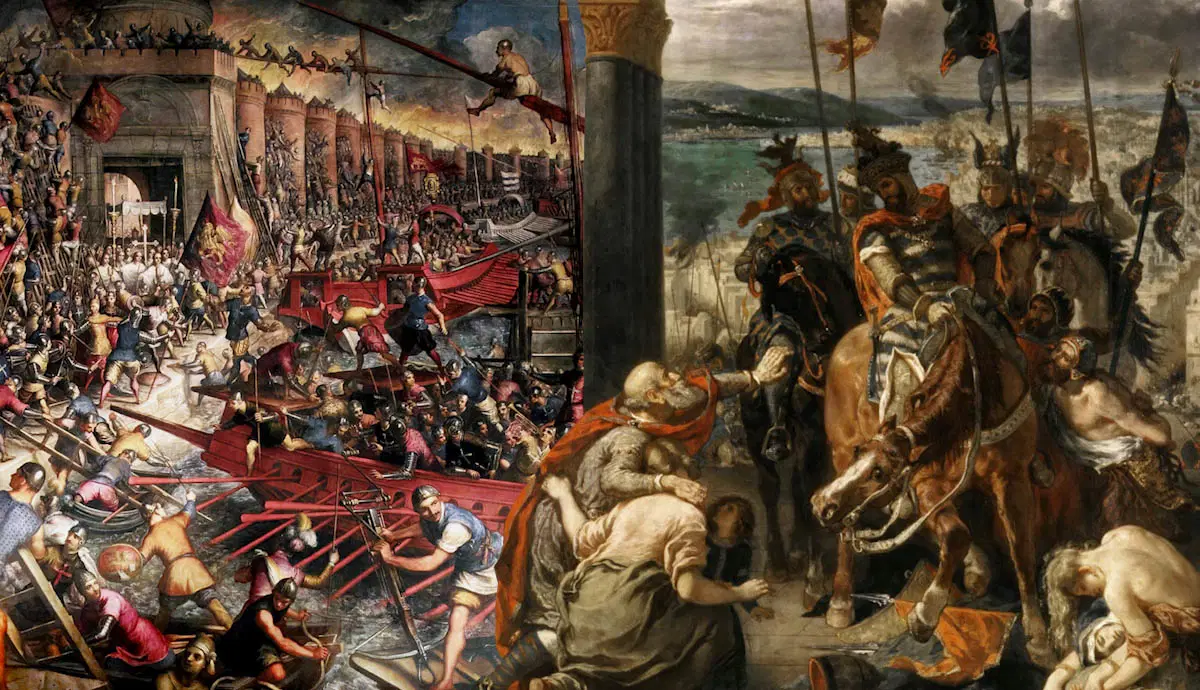The Fourth Crusade, called by Pope Innocent III in the early 13th century, was one of the most shocking and transformative events in medieval history. While the Crusades were initially conceived as a religiously motivated series of campaigns to reclaim Jerusalem from Muslim control, the Fourth Crusade took a devastatingly different path, forever altering relations between the Latin West and the Orthodox East.
At its inception, the Fourth Crusade was meant to capture Jerusalem, following the failed attempts of previous Crusades to regain control of the holy city. However, the course of this campaign took a disastrous detour when financial difficulties marred the Crusaders’ efforts. Unable to pay for the massive fleet they had ordered from Venice, the Crusaders turned to the Venetian Doge, Enrico Dandolo, for assistance. Dandolo offered to suspend the debts, but only if the Crusaders would first assist him in capturing the city of Zara (modern-day Zadar, Croatia), a Christian city that had rebelled against Venice.
This unexpected diversion was just the beginning of a series of complex political maneuvers that would ultimately lead the Crusaders to Constantinople, the magnificent capital of the Byzantine Empire. Venice, with its vast commercial interests, had long seen the Byzantine Empire as a rival, and the fall of Constantinople would serve Venice’s ambitions. In a series of negotiations, the Crusaders were persuaded to support the claim of Alexios IV Angelos, the son of the deposed Byzantine emperor Isaac II, in exchange for substantial financial and military assistance.
Once Alexios IV was installed as emperor, he promised the Crusaders the support they needed: 10,000 soldiers and 200,000 silver marks. However, Alexios IV's rule was short-lived. He was overthrown by a rival, Alexios V, who had little interest in fulfilling the promises made to the Crusaders. Faced with the loss of their promised reward, the Crusaders—already deeply entrenched in their pursuit of wealth—decided to seize Constantinople for themselves.
What followed was a brutal and senseless sacking of one of the greatest cities of the medieval world. For three days, the Crusaders rampaged through the city, overcoming the walls of Constantinople and entering its heart. What they found was not just a city rich in wealth and beauty but a symbol of Eastern Christendom. The destruction was catastrophic. Churches, including the Hagia Sophia, were desecrated. Priceless religious relics were shattered or stolen. The wealth of the Byzantine Empire was plundered, and the people of Constantinople were subjected to unimaginable suffering. Women were raped, men were killed, and children were enslaved. The cry of grief echoed throughout the city, a sound that still resonates in the historical record through the words of the Byzantine historian Nicetas Choniates: "No one was without a share in the grief... the groaning of men, the shrieks of women, wounds, rape, captivity… All places everywhere were filled full of all kinds of crime."
The damage to the Byzantine Empire was not just physical but psychological. The sack of Constantinople marked the beginning of the end for the once-great empire. Its infrastructure was severely damaged, its wealth was looted, and its political stability shattered. Though the Byzantines would continue to struggle for survival in a diminished form, the event solidified a deep rift between the Roman Catholic and Eastern Orthodox churches, a divide that persists to this day. The Fourth Crusade, which was meant to unite Christendom in the name of religion, instead drove a wedge between the Latin and Orthodox Christian worlds.
The legacy of the Fourth Crusade is still felt in the modern world, particularly in the way it shaped the course of East-West relations. The trauma inflicted by the sack of Constantinople, coupled with the centuries of tension that followed, has had lasting repercussions for the Eastern Orthodox Church and its followers. The Crusaders' actions sowed seeds of resentment that would fester for generations, and the memory of the sack of Constantinople remains a bitter one for many in the Orthodox Christian world.
Today, some of the treasures looted from the city, such as the famed bronze horses of Saint Mark’s Basilica in Venice, serve as a symbol of the Crusaders’ triumph over the Byzantines, but they also stand as a reminder of the cost of that victory. The horses, which once adorned the Hippodrome of Constantinople, were taken during the sack of the city and eventually relocated to Venice, where they remain as a symbol of the city’s wealth and power.
However, the deeper wounds inflicted by the Fourth Crusade cannot be so easily quantified. The breach between the Catholic and Orthodox churches, exacerbated by the events of 1204, has lasted for centuries, and while efforts at reconciliation have been made, the scars of that time are not easily erased. For the Eastern Orthodox Church, the Fourth Crusade remains a painful chapter in its history, one that symbolizes not only the destruction of a great civilization but also the betrayal of a Christian brotherhood that could never truly heal.
The political fallout of the Fourth Crusade also had lasting consequences. The Byzantine Empire, already weakened by internal strife and external pressures, was left vulnerable to the rise of new powers in the region. In the decades that followed the sack of Constantinople, the once-mighty Byzantine Empire was reduced to a series of small, fragmented states, ultimately falling to the Ottoman Turks in 1453.
The impact of the Fourth Crusade extended beyond the fall of Constantinople. It marked the beginning of a new era in European geopolitics, one where the ambitions of rising powers like Venice, Genoa, and the Papacy would continue to reshape the political landscape of the Mediterranean and beyond. The Crusaders, having failed in their original mission to liberate Jerusalem, now focused on controlling key territories and expanding their influence in the region.
For the Venetians, the sack of Constantinople was a great victory, and they were able to capitalize on the chaos that followed. The Venetian Empire, already a dominant naval power, grew even stronger, solidifying its control over key trade routes and further enriching its coffers. But this victory came at a price. The Venetians, like the Crusaders, would face the long-term consequences of their actions, particularly in terms of their relationship with the Eastern Orthodox Church and the Byzantine world.
The Fourth Crusade, then, is not just a story of religious zeal gone awry but a tale of power, betrayal, and the high cost of ambition. It serves as a stark reminder of the consequences of unchecked political and religious motivations, a lesson that still resonates in today’s world of complex international relations. While the wounds inflicted on Constantinople may have healed in some ways, the scars of the Fourth Crusade remain visible to this day, etched into the history of both the East and the West. The rift between the Latin and Orthodox worlds, born in the streets of a ravaged Constantinople, is one that time has been unable to fully mend, and the legacy of that fateful crusade continues to shape the course of history, even as we look to the future.

























0 Comments